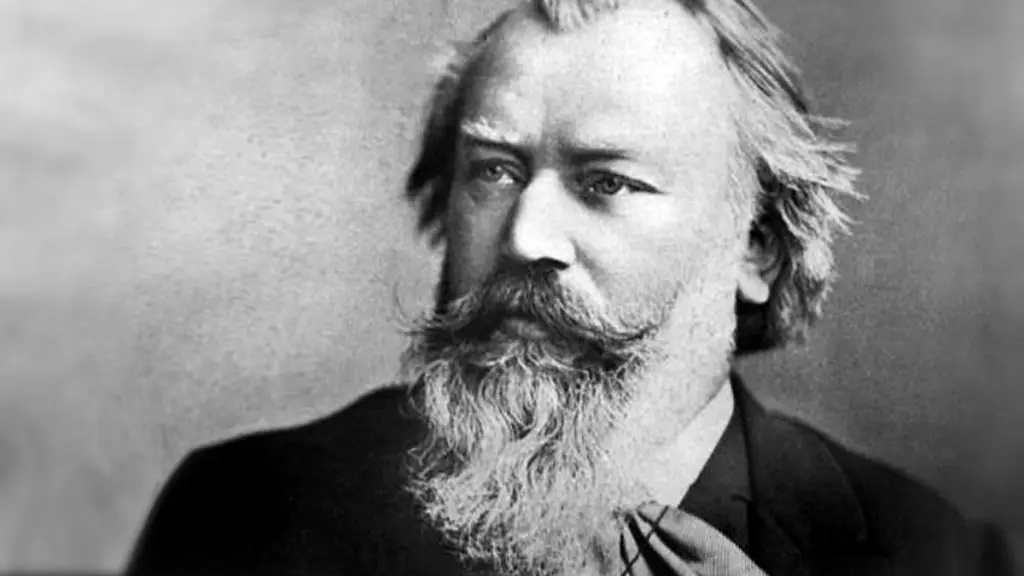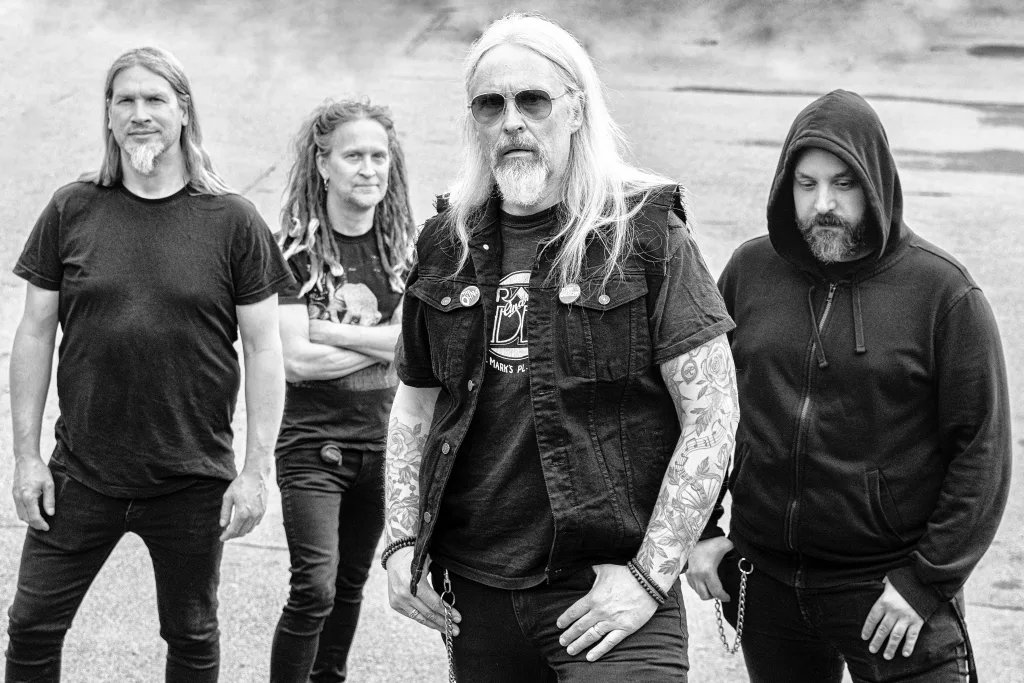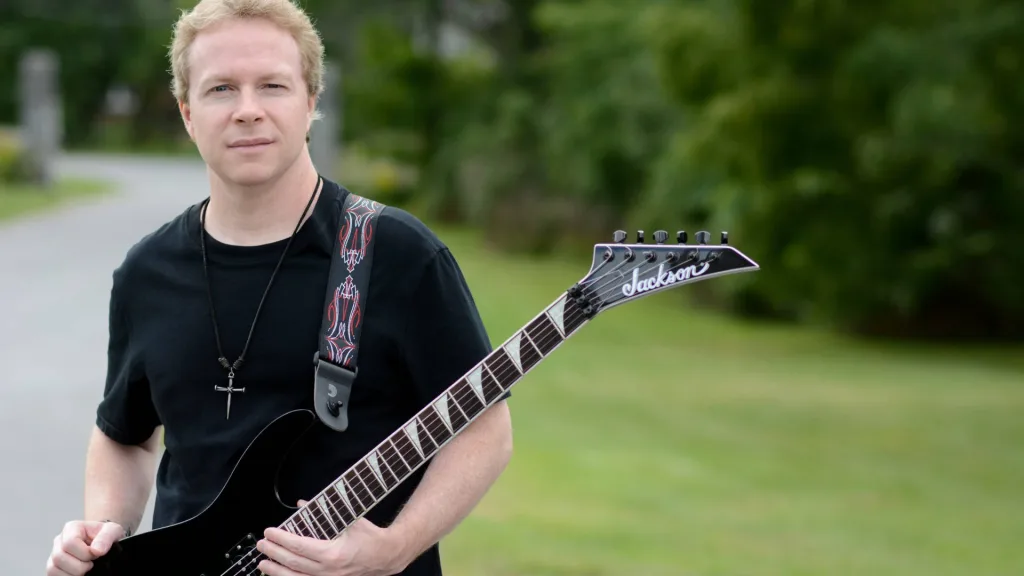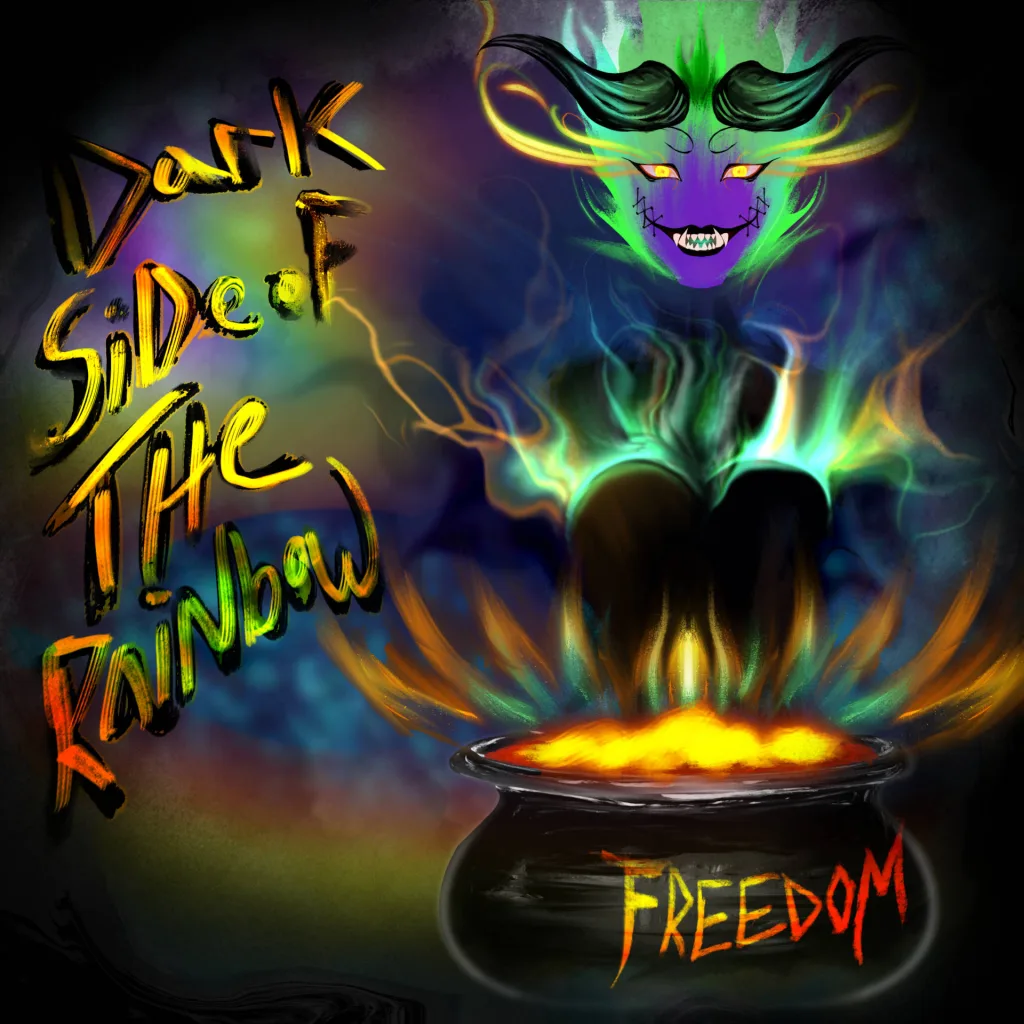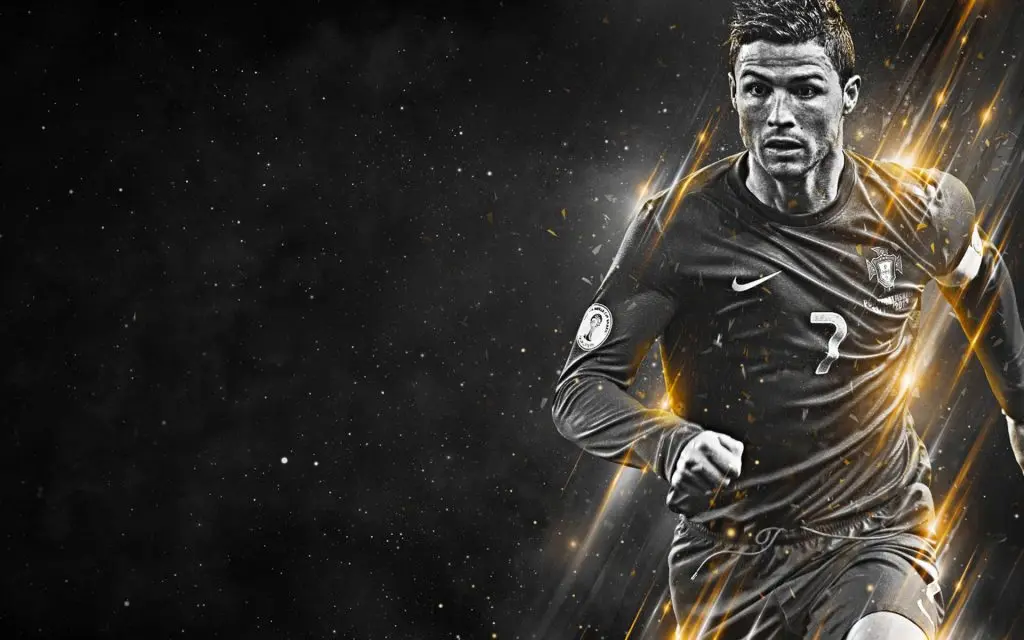Van Halen – The History and Making of their debut album
Written by Kevin Tanza on November 6, 2020
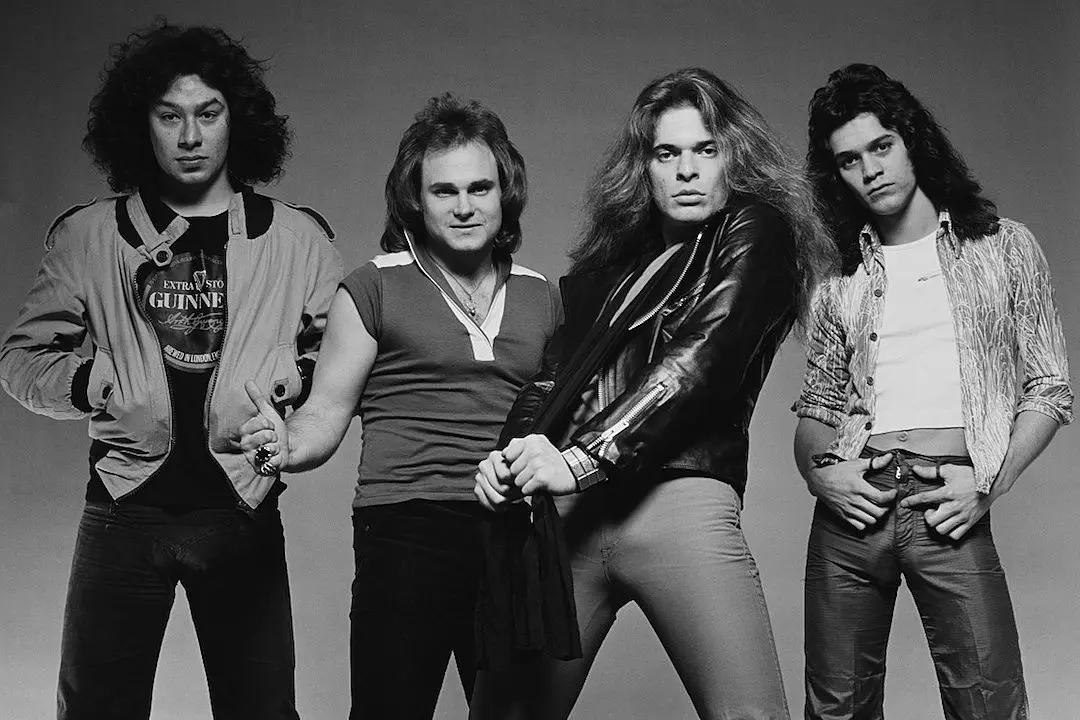
“I hope it (the album) does okay. All we’re trying to do is put some excitement back into rock ‘n’ roll. It seems like a lot of people are old enough to be our daddies and they sound like it or they act like it. They seem energy-less. It seems like they forget what rock’n’ roll is all about.”
https://www.youtube.com/watch?v=i5txwFv-zYM&ab_channel=VHTelevision
There are very few albums that can truly be defined as generational. Pieces of musicianship that changed the landscape at the time of its release and altered our perception of what that genre could be. And to do it with swagger, attitude and an endless amount of energy is a feat that only the greatest in their craft can achieve.
Van Halen’s 1978 self-titled debut album is such a piece of musicianship–an album that was an absolute revolution in the Hard Rock scene of the late 70s and made a paradigm shift in the way the genre was played to kick off the 1980s. You cannot understand the commercial and cultural height of Hard Rock in the 80s without the influence of Van Halen–that combination of vocal harmonies, catchy choruses, extremely proficient guitar work and overall sheer dynamism and energy is something that was established by this band’s debut.
But above all things, there was an element of showmanship in Van Halen that made them stood out from the rest of their generational cohorts. Everything was done over the top, everything was a show and everything was done to entertain. At a time when Hard Rock took itself too seriously, all of the sudden this American band completely changed the landscape and did so with a sense of humor and willingness to have a good time that very few bands can combine with such musical craftsmanship.
Whether it was with David Lee Roth or Sammy Hagar on the microphone, Van Halen is one of the definitive Rock bands of all time and their entire body of work is a huge testament to that, but their debut album is their greatest achievement, in my view, because they showcased from the get-go what they were all about. Perhaps with the exception of Led Zeppelin and Black Sabbath’s debuts, no other Rock album has had the degree of cultural and influential impact that Van Halen’s debut had and that is due to a lot of factors we’re going to cover today.
One of the most important Rock albums of all time, there is a lot to unpack about Van Halen’s debut, its history and making, so get ready because this is going to be a long ride.
The context.
https://www.youtube.com/watch?v=9X6e7uctAww&ab_channel=VHTelevision
“I believed in Van Halen and wanted them to break through. But what was a bit weird for me was that most people at the record company weren’t high on their music. When I’d play the record, nobody there was enthused. That was upsetting because, honestly, that meant that nobody at the label was really interested in Van Halen as one of the promising new acts for 1978. Meanwhile I was sold 100 percent on these four guys. It was like dating a girl in high school that you thought was the biggest catch, and all of your friends thought she was nothing special.”
- Producer Ted Templeman about Van Halen in his autobiography, A Platinum Producer’s Life in Music.
Despite being highly regarded as one of the greatest musical acts of the United States’ history, the history of Van Halen actually begins in Amsterdam, the Netherlands, where the brothers, guitarist Edward and drummer Alex Van Halen, came from. They were born in the 50s, but eventually moved to the United States in the late 60s and music was always a big of their everyday life, especially considering that their father, Jan, was a jazz saxophonist and clarinetist.
As one can imagine, even during their childhood, they were already starting to play musical instruments and that became a constant throughout the years, as we know by now.
“We both started playing piano at age six or seven,” Edward Van Halen said to Guitar Player in 1978. “And we played for a long time. That’s where I learned most of my theory. We had an old Russian teacher who was a very fine concert pianist; in fact, our parents wanted us to be concert pianists.”
Of course, piano and keyboards are musical instruments Edward came to play with in many different stages of Van Halen’s career and even became a key component of the band’s sound during the Sammy Hagar years, so those formative years in the Netherlands had its own degree of influence in the brothers, which would permeate in the future. Having said that, once Edward arrived to the United States and was introduced to the likes of Jimi Hendrix and Cream, with Eric Clapton’s incredible guitar work being a particular influence of his, he discovered the guitar and that was how his love story with the instrument began.
“I used to love the way he (Clapton) played,” Edward said in an interview in 1978. “He was real smooth and a lot of feeling. Every review I ever read of the album or my playing, it’s always Blackmore, Beck and Page influences. But I never really sat down and copped their licks like I did Clapton.”
Despite finding joy and comfort in the booming Rock scene of the late 60s, the first years of the Van Halen household in America were not smooth, to say the least, with the entire family struggling to adapt to a new culture, a new way of doing things and, especially, a new language.
“My dad was a professional musician, and he ended up having to wash dishes and work as a janitor,” Edward recalled in 2015. “My mom was a maid. I’ll never forget, we used to help my dad wax floors at the Masonic Temple in Pasadena. (I) learned how to use one of those floor waxers (and) helped my mom clean houses. But what saved us was music.”
These elements of struggle and work ethic were a key factor during Van Halen’s early years as a band since they would go on to almost five years of dedication before landing a deal with Warner in 1977. The band would usually play up to seven shows per week during those early years and constantly rehearse to fully develop their abilities, so it’s hard not to see that culture of work starting in their home. This is a sentiment that is echoed by the band’s first vocalist, David Lee Roth.
“The Van Halens (Edward and Alex) and I have had steady jobs since we were 12 years old,” Roth recalled in 2012. “Mine was working before and after school at a horse stable. For them it was paper routes. Mr. Van Halen was classic European: you’re making your money for the rent. I was lucky I didn’t have to do that … Even at your worst moments, there’s a whole lot of Shakespeare going on. How can you not appreciate it? At your lonesomest, most catastrophic, it’s still pretty cinematic. I think the smiles were genuine. Don’t mistake them for simplistic grins – there’s a lot of pirate smiling.”
As one can imagine, growing up in a musical environment and constantly trying new instruments (Alex would eventually go for drums and Edward for guitar), the Van Halen brothers would start their own bands in Pasadena, California, in the early 70s, often trying different names, playing in parties and at school, with the usual results that you can expect from musicians at such a young age–very raw and still learning their craft.
One of the earliest incarnations of Van Halen was actually called Genesis, but in 1972 they discovered that there was obviously another band with that name and they switched to Mammoth, with Alex on drums, Edward as the vocalist and guitarist and a man named Mark Stone on bass. Eventually, Edward would get tired of doing vocals because he couldn’t focus too much on the guitar, which was his main passion, so they decided to start doing auditions for vocalists.
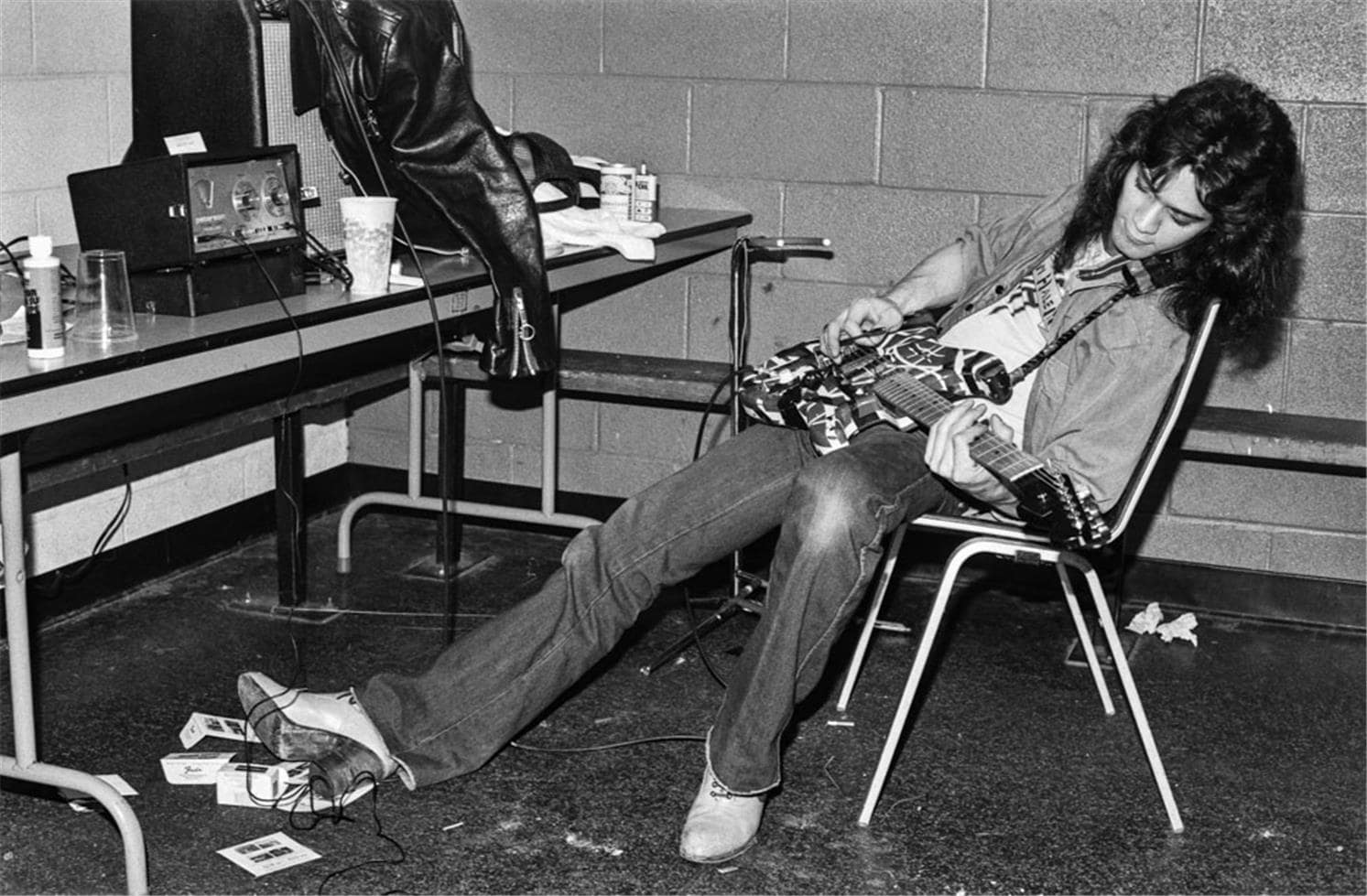 Edward Van Halen in 1978.
Edward Van Halen in 1978.
Now, this is a very interesting anecdote. Based on what has transpired throughout the years, Edward and Alex were not impressed by the singers they auditioned at the time, but they also had a running problem with the P.A. system they were using because it was becoming too expensive for them. And they discovered that the owner of said P.A. system was a singer and he was interested in the position of being Mammoth’s vocalist.
That guy was obviously David Lee Roth.
Roth, in a notorious contrast to the Van Halen brothers, came from a wealthy family due to his father being a successful ophthalmologist. And while David didn’t have a very stable project when it came to the music business, at the time he met paths with the Van Halens, he had a small group called Red Ball Jets, but that wasn’t really going to any promising place. Actually, Van Halen’s manager from 1979 to 1985, Noel E. Monk, had a very interesting assessment about David Lee Roth and his role within the band in his book, Runnin’ With the Devil:
“David’s obvious and valuable talents in some areas counterbalanced his over-the-top behavior in others—both on and off the stage. Edward was the most talented and artistically gifted member of the band, but David was the brightest and most broadly creative, with a vision that went well beyond simply playing music and getting laid. Yes, his intelligence was equaled and sometimes obviated by his bombastic, demanding, and occasionally cruel behavior. Diamond Dave was a hyperactive showman from the start and ultimately a diva of the first order, and his mighty tantrums frequently gave those around him the sense that disaster was imminent. But he did have a vision for Van Halen, and for himself, and he made that vision a reality. He had help, obviously, but there is no question that, among the four members of the band, David was the true leader.”
One of the running issues in the early days of Van Halen were Roth’s vocals, as a lot of people, including Edward and Alex, were really not huge fans of. And based on Roth’s statements throughout the years, it’s pretty clear that there was a certain level of animosity within the band way before they even got a record deal.
“There were always creative differences,” Roth said in 2020. “We never got along. It was a beautiful, beautiful pairing of… you’ve seen cowboy movies where the guys are always sabotaging each other, but they’re working to somehow accomplish something, and I think you’ll see that in a lot of popular bands.”
It’s hard to argue with Roth’s logic. From the get-go you can tell that Van Halen (who were named like that because of the vocalist’s suggestion, according to himself) was a melting pot of many different influences and sounds, but it was Roth’s histrionics as a front man and his looks that gave the group the capacity to impress even more during live performances. Even if he wasn’t the greatest vocalist from a technical perspective, his swagger, his attitude and just sheer amounts of energy was something that was a phenomenal counterbalance to Edward’s obscene levels of talent on the guitar.
https://www.youtube.com/watch?v=1gMGh0RmOxw&ab_channel=VANHALENARCHIVE
Van Halen live in Pasadena in 1975.
Eventually, Mark Stone would be kicked out of the band because of creative differences and Van Halen would be in need of a bassist. Around that time, Alex was friends with the bassist of a local band called Snake, Michael Anthony, with the former convincing the latter to go jamming with them one night. The band was impressed not only by Anthony’s bass playing, but also because of his background vocals and the capacity to do vocal harmonies with Roth (more on that later in this article).
“While he may not have been the greatest bass player in history, Michael was a solid supporting player whose most underrated skill might have been his ability to provide backing vocals during live performances,” Monk said about Anthony in his book. “He actually had a very nice voice and was perhaps a more technically proficient singer than David, but there is more that goes into being a lead singer than just technical proficiency, and Michael certainly had neither David’s charisma nor his unique stage presence. He was content to be a role player and he filled that role exactly as it was written.”
Anthony himself was impressed by the band’s musical acumen and decided to dropped off high school and discard his plans of going to challenge to pursue his rock ‘n’ roll dreams, which his father took it as you might expect.
“He kicked me out of the house! But the band was getting huge, locally and it was either now or never,” Anthony said many years later. “I would’ve shot myself if the band had made it without me. After we played our first tour, I bought my parents a car and they became my biggest fans.”
And so, the first and classic Van Halen lineup was fully formed. The band would go on to play virtually in every single club, bar and backyard party willing enough to have them, constantly developing their craft and improving their live performances, which started to build up their reputation as one of the finest shows you could get in California at the time.
Of course, this was also at a time where Hard Rock was starting to go down in popularity in the mid-70s and Pop and Disco were becoming a lot more prominent, along with Punk. This was something that played a role in the band’s performances at the time because they adjusted to the demands of the time, which is something that influenced Van Halen’s sound to be what it has been for so many years.
“Yeah, we used to do some old James Brown, ‘It’s Your Thing’, but then again at the other end, we did some Deep Purple, we did some Black Sabbath, we did ‘Deal with the Preacher’ by Bad Company,” Alex Van Halen said in 1981. “You name it, we played it. We played anything and everything, and it seemed that the wider the scope of the style of music, we played any music but jazz. People just didn’t know how to dance to it. We didn’t really care for it that much. So it really wasn’t bankable, we didn’t want to introduce a sax section.”
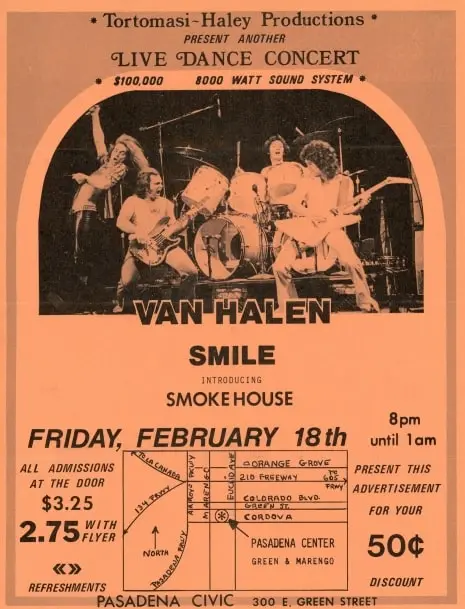 A flyer for a Van Halen concert in 1977, a year before the release of their debut album.
A flyer for a Van Halen concert in 1977, a year before the release of their debut album.
The critics and the “experts” were not really enthusiastic about them as Hard Rock wasn’t the hot trend at the time, but they did have one man that became a huge fan and gave them support from the very moment he saw them live.
“It was an off night in 1977 and somehow I wound up going to the Starwood Club,” Gene Simmons of KISS fame said in 2020. “I’d never heard of Van Halen; I was there to see a group called the Boyz. You go upstairs to the ‘you’re so fabulous’ area and downstairs are the fans. So I’m waiting for the Boyz and on comes the first band. They’re making this furious noise with all these melodies coming out of the guitar like I’d never heard before.
“I went to the front of the balcony and looked over. You saw Roth without his shirt on, and Alex playing the crap out of the drums and Michael pumping away. And then this guitar player doing things with his hands on guitar I would never have imagined. Nobody was using backing tracks or AutoTune or any of that crap. This was authentic.”
The story of Gene Simmons discovering Van Halen and helping record a three-track demo is very well-documented and it is part of Rock’s vast folklore, but the reality is that even that didn’t do the band a lot of favors in the sense that they were still ignored by the vast majority of labels in the States. As we have stated before, they were not following any major popular trend at the time and that was part of the reason they were mostly ignored, plus their combination of so many different styles and Edward’s blazing guitar work was something unheard of in the late 70s.
It’s hard to imagine this now, but Van Halen was a band struggling a lot in their formative years and what kept them going was the following they were building and this never-say-die attitude that molded them into some of the best live performances ever recorded. Listen to some of the Van Halen shows before the release of their debut album and the degree of power, energy and hunger is almost palpable–I would go as far as saying that their best concerts were in this particular time.
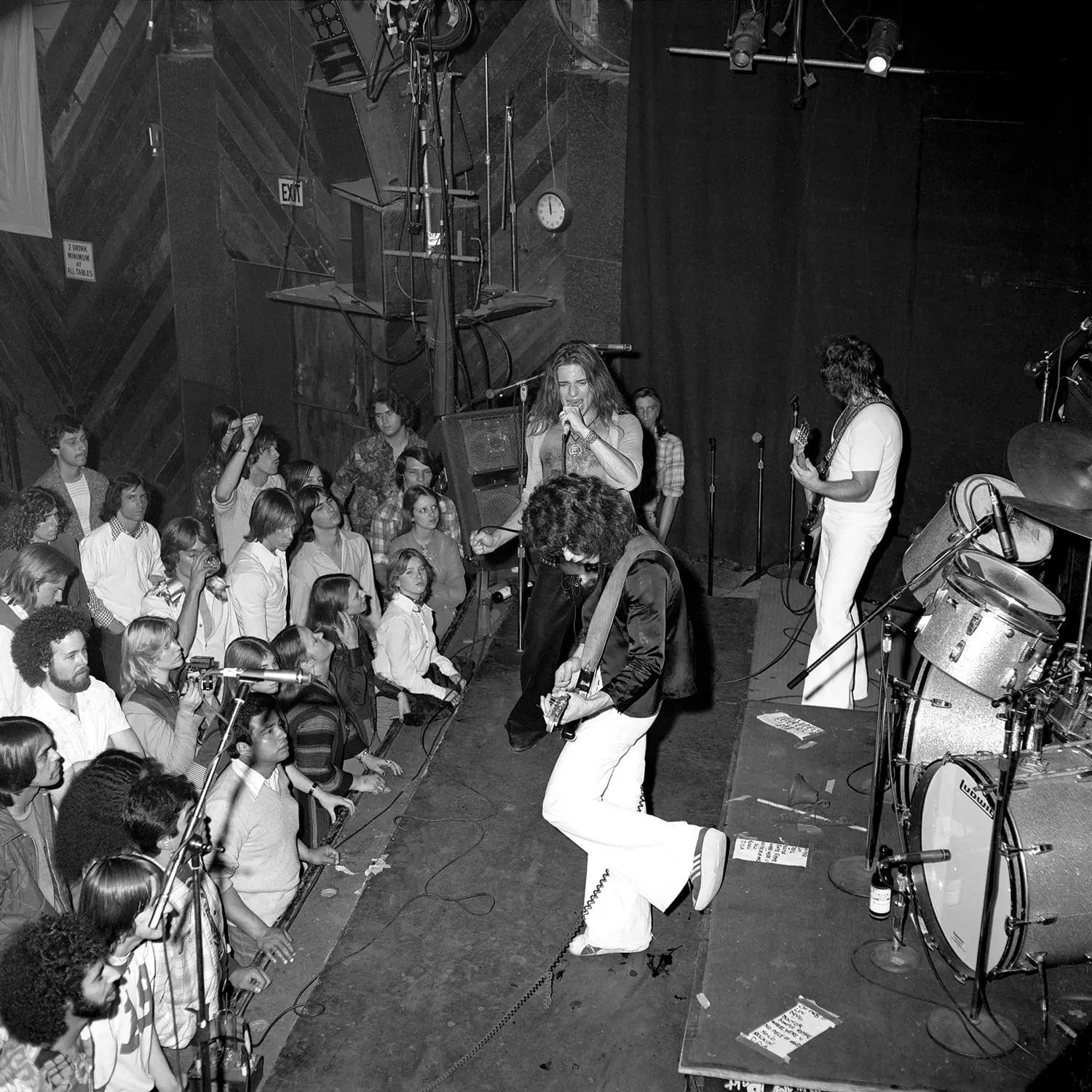 Van Halen live at the Starwood club in 1977.
Van Halen live at the Starwood club in 1977.
“Bands like Sabbath, Zeppelin and Deep Purple were either defunct or entering the last phases of their career, and classic hard rock was largely a thing of the past,” says Mike Kelley. “Van Halen, with their arena-rock presentation and Roth’s blatant Jim Dandy/Black Oak Arkansas-clone antics, were a throwback to a bygone era. But despite what appeared to be bad timing, they offered a classic rock’n’roll experience and a new post-Hendrix guitar innovator.”
Along with the Starwood, they also became regulars in major clubs of the Sunset Strip such as the Whisky a Go Go and Gazzarri’s in 1977, with the band holding a very strong reputation as a fierce live act and Eddie was also gaining compliments and recognition as perhaps the hottest upcoming guitarist in the LA scene at the time, along with Quiet Riot’s Randy Rhoads, who would go on to have his own legacy working with Ozzy Osbourne. For many Van Halen fans, the concerts of this particular period of the band’s trajectory are the stuff of legends and show them in the absolute height of their powers.
“The lights went down and the announcer introduced Van Halen and the kids went nuts and started screaming,” former Van Halen manager Marshall Berle said in photographer Neil Zlozwer’s 2011 book, Eddie Van Halen – Classic Shots: 1978-1984. “They started playing and the hair on the back of my neck stood up. I got a chill right through my bones. I had never seen anything like this in my life. These guys were so good I almost crapped my pants. I thought ‘what the fuck is this?’”
Eventually, a major label would pick up on the promise and talent that this band had. By mid-1977, Mo Ostin and Ted Templeman of Warner Bros. Records would saw Van Halen live and they would come to the realization that this group had something really special. The one that was pushing for the group to get signed was Templeman, who was not only vice-president of Warner at the time and whose work as a producer was already highly-regarded, having worked with the likes of the Doobie Brothers, Montrose and Van Morrison. And yet, with all his experience, he was blown away by Van Halen.
“When Van Halen came onstage, it was like they were shot out of a cannon,” Templeman said in his autobiography, A Platinum Producer’s Life in Music. “Their energy wowed me, especially because they performed like they were playing an arena and not a small Hollywood club. So my interest was piqued, even though their singer didn’t impress me. At that moment that didn’t matter much, because their guitar player blew my mind.”
“Right out of the gate I was just knocked out by Ed Van Halen. It’s weird to say this, but encountering him was almost like falling head over heels in love with a girl on a first date. I was so dazzled. I had never been as impressed with a musician as I was with him that night. I’d seen Miles Davis, Dave Brubeck, Dizzy Gillespie, all of those transcendent artists, but Ed was one of the best musicians I’d ever seen live. His choice of notes—the way he approached his instrument—reminded me of saxophonist Charlie Parker. In fact, as I watched, I was thinking there are two musicians in my mind who are the absolute best of the best: Parker; jazz pianist Art Tatum; and now here’s the third game changer, Ed Van Halen. So right away I knew I wanted him on Warner Bros.”
Getting the band on board was easy–after all, they had been fighting and working for a deal with a label for five long years. The hard part for Templeman was to convince the people in Warner to bet on a band that simply wasn’t following any musical trend at the time. But Ted being very business-savvy at the time and having enough experience and influence within the company, he managed to locate the necessary budget to invest in the band, not only to record the album, but also in terms of marketing, publicity and to schedule shows for them to perform, even before the release of the album.
Looking back now, in a day and age where the labels’ power is pretty much gone, the level of investment and marketing that Van Halen enjoyed on their first album was certainly a tremendous risk, but it also showed Templeman’s honest belief in the band and their potential. And for all the talk about producers or other people in the industry always screwing musicians up, credit has to be given when it’s due.
With the album fully recorded (more on that later), the band decided to do a final show in Pasadena before parting to their official tour as a signed group. Edward invited Templeman to watch the show and that performance reassured the producer that he bet on the right horse–you can hear it for yourself.
https://www.youtube.com/watch?v=SJnDy5RgP4c
Van Halen’s last show at the Pasadena Civic Auditorium, October 15th, 1977, often known as “The Nightmare before Halloween”.
“The whole crowd was pumping their fists,” producer Templeman said in his autobiography about the band’s final concert in Pasadena. “It was like I was at a Beatles concert in the middle of Pasadena, and Van Halen didn’t even have a record out. That was great to see and a confidence booster for me as their producer. The game changer—I’m telling you, maybe the most emotional moment in music, for me, ever, in anything—was when I heard them play that song that night.”
Van Halen were ready to record their debut album and take advantage of the opportunity they wanted and fought for during five years of pure hard work. And as cliché it may sound, things were never going to be the same for the band and for Hard Rock in general.
In the words of Templeman, this was the game changer.
The album.
“I can point for you and go: right there we’re imitating Eric Clapton; right there I’m imitating vocally David Bowie; right there is Bruce Springsteen (…) but this is how you create a signature sound. If you’re lucky to have it, there’s no way around it. I actively imitated everything from the Nicholas Brothers tap dancing to Mick Jagger going ‘Oooh yeah!’ But because of whatever it never sounds like anything to you but David Lee. And when Edward plays you might never have heard the material before but you instantly recognize it as fast as, say, Jimi (Hendrix)’s guitar.”
Looking things in retrospect with such big bands is very interesting because you get some beautiful ironies. For example, the guys of Van Halen had to wait a few months to record their debut album in 1977 because Ted Templeman was busy producing the Doobie Brothers’ Livin On The Fault Line album. To think that a group starring the likes of David Lee Roth and Edward Van Halen was playing second fiddle in a label’s priorities is funny, to say the least.
Regardless of that, Van Halen eventually entered Sunset Sound Recorders in Hollywood in August 1977 and the band quickly recorded the album in just 21 days, which is incredible when you think about it–that one of the greatest albums of all time was recorded in just three weeks. Templeman was smart about it: he was blown away by the band’s live performances and knew that to get the most out of the songs was to record them as organically as possible, which is why the vast majority of the songs have very little studio elements.
But that didn’t mean there weren’t issues with the recording process, especially at the beginning. And the issue was very clear: Templeman wasn’t sure that Roth was the right voice for Van Halen.
“Van Halen’s biggest issue was one that as a producer I feared I couldn’t fix,” Templeman said in his autobiography. “The truth was that Dave’s performance in Sunset Sound only raised my anxieties about his abilities. Some of his vocal performances, to be frank, just weren’t acceptable. To be sure, he was distinctive as a singer; his train-whistle screams were identifiable in a good way. But every time I heard him get pitchy or completely miss a note, I worried that the public was going to be turned off by this band because of his limitations.”
What’s even more interesting than this is the fact that Templeman was already considering, all the way back in 1977, before Van Halen made it big, to hire Sammy Hagar as the band’s vocalist, due to the relationship the producer had with the Red Rocker because of their collaboration in Montrose and because Templeman felt he was the most fitting voice for this particular project.
The thought of Van Halen’s debut with Hagar’s vocals is at least very curious and at most surprising, but no one can deny that Roth’s signature singing style and charisma made a lot of those songs work, which is something that Templeman has admitted throughout the years and that it was the right call to not fire Diamond Dave and not go for Hagar.
Another thing that got the producer’s attention and even belief that Roth could make it at Van Halen was the many rehearsal sessions Templeman spent with the band before getting into the studio, where he managed to get to know the band a lot more. One of the things that got his eye was not only Roth’s virtues as a lyricist, but also his working attitude and his capacity to constantly strive to improve himself, which convinced him that he could cut it as the vocalist of a big band.
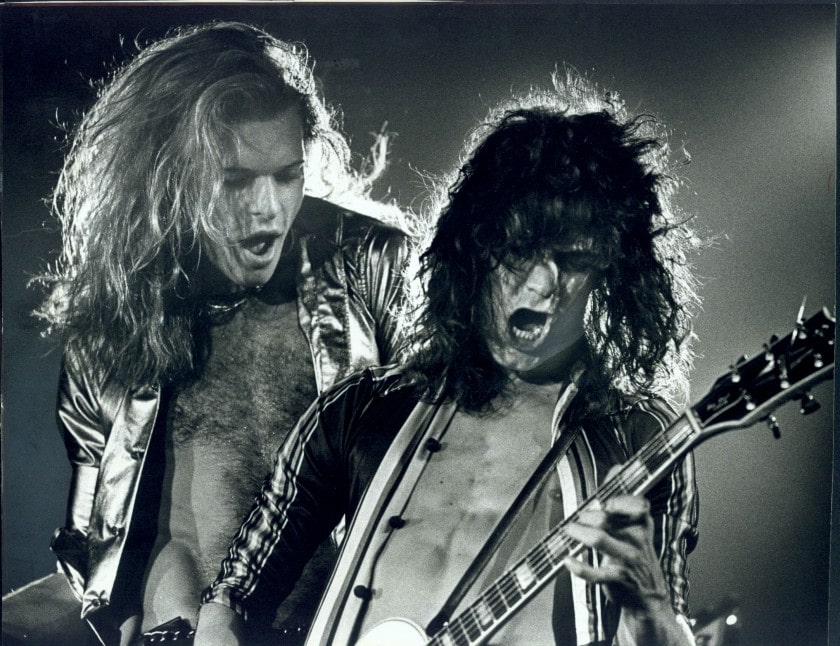 David Lee Roth and Edward Van Halen in action in 1978.
David Lee Roth and Edward Van Halen in action in 1978.
“So for me solving the puzzle of how to make Roth work within the confines of Van Halen came down to this: He wasn’t a conventional singer, to be sure,” Templeman said in his book. “But he had certain gifts that were rare in the rock world, and those assets outweighed his flaws. In the end I hung in there with Dave, thinking that I’d find a way in the studio to accentuate his strengths and minimize his weaknesses. That’s why I decided against calling Sammy. I love Sammy as a person and as a singer, but if I’d tried to put him in Van Halen in 1977, I’d have made the biggest mistake in rock history, because Van Halen never would have made it without Dave fronting the band.”
Once all that was settled, the recording process was fairly smooth, with both Templeman and the band aiming to get a very organic and realistic sound in each song, faithful to their live performances at the time, so it’s not surprising that there is a musical flow of sorts in each track, where the obvious standout part is not only Edward Van Halen’s guitar work, but also his tone, which he has called his “brown sound”.
“I’ve got six old Marshalls, which have been rebuilt,” Edward Van Halen about his equipment said in an interview in 1978. “They have bigger tubes in ’em and bigger transformers to make ’em a lot louder. I use six heads hooked to six cabinets. The cabinets are pretty much stock except I changed the way they look a little bit. And I use these things called voltage generators. What this box does is it enables me to put one-fifty or one-sixty watts. It enables me to crank up the voltage higher than the amp is supposed to take.”
Using overdubs was certainly common practice at the time, but Templeman worked pretty close with his longtime sound engineer Donn Landee and had enough experience to understand that the best thing they could do with this band was to focus their sound on Edward’s guitar and maintain overdubs at a minimum, with only Runnin’ with the Devil and Jamie’s Cryin’ being the exception to this rule.
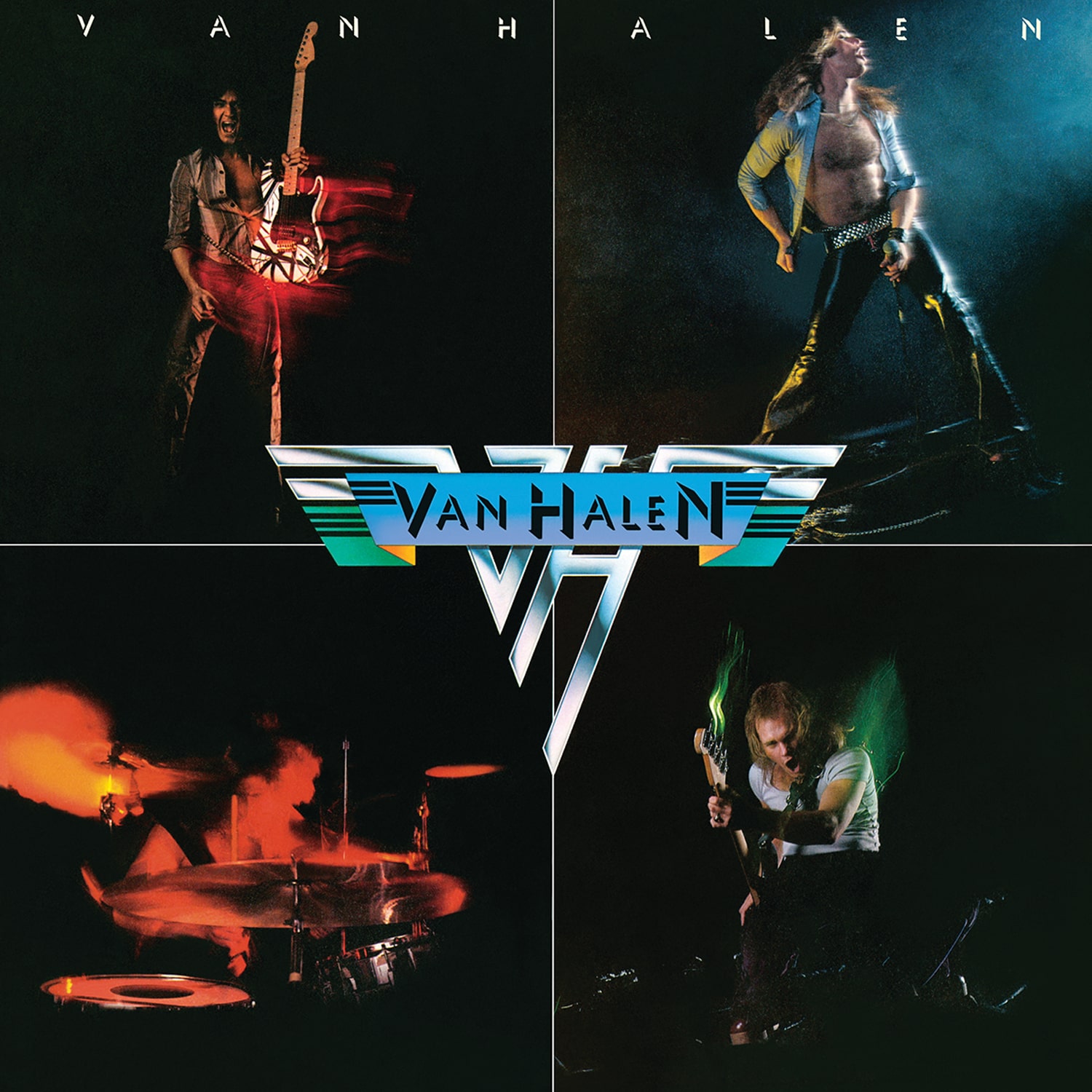 The cover of Van Halen’s debut album.
The cover of Van Halen’s debut album.
Of course, one core element of the band’s sound that has been sadly undermined throughout the years by Edward Van Halen due to personal differences are Michael Anthony’s background vocals. The vocal harmonies that Van Halen’s bassist used to do with Roth have become an intrinsic cog in the group’s musical machinery, especially in this particular album, and while Edward tried to lessen Anthony’s contributions because of the petty nature of their breakup a few years ago, Diamond Dave had only but praise for his former bandmate when asked about him.
“What we have at our fingertips is arguably one of the greatest high tenor voices ever — that was in Michael Anthony,” Roth said in 2013. “In our tiny little corner of the universe, that voice is as identifiable as the high voice in Earth, Wind & Fire, as identifiable as the high voice in the Beach Boys … so I would always look forward to that reunion.”
One could easily pinpoint the opening bass lines of Runnin’ With the Devil as Anthony’s sole contributions to the debut album, but this would be doing him a disservice as the background vocals and harmonies of songs such as Little Dreamer, On Fire, Ain’t Talkin’ ‘Bout Love or the aforementioned Runnin’ With the Devil make tracks hit the way they do with the listener.
In fact, Anthony was Van Halen’s secret weapon and a key element in the band’s live performance as he was a phenomenal backup singer to Roth and later on to Sammy Hagar, who has always given Michael the credit he deserves. Van Halen’s pop sensibilities cannot be fully understood without the man’s background vocals and his simple but yet effective bass work is a necessary balance to Edward Van Halen’s histrionics as a guitarist or David Lee Roth’s showmanship.
And at the end of the day, that is what made the band’s debut so special and everlasting: the fact that it was the conglomeration of many different traits of many different music styles all in one sound, complemented (and perhaps, even perfected) by the quintessential example of what a guitar hero should be. Hard Rock existed before Van Halen, but not without this Pop accessibility and with such a straightforward approach–it’s music that you can enjoy from the first listen, without even being a Rock enthusiast.
The second the opening bass lines (ironic of having Michael Anthony kick starting one of the most important Rock albums of all time) of Runnin’ with the Devil begin, you already know that you are getting into something special, which is all but confirmed when we hear Edward Van Halen’s signature guitar tone and that amazing main riff.
David Lee Roth shows from the very first song that he is up to the task of being Van Halen’s singer and every single doubt that Templeman ever had faded away, showing swagger, attitude and charm as well as hooks. That chorus, where Roth’s voice perfectly combines with Anthony’s in beautiful harmonies, really makes the song and then Edward jumps in with his a few guitar licks that are simply breathtaking.
Just like that, in a little bit more of three minutes, one of the greatest bands of all time started with a bang.
https://www.youtube.com/watch?v=M4Czx8EWXb0
To talk about the second track, the guitar instrumental Eruption, is to talk about one of the definitive and most influential guitar pieces in the history of music, influencing millions of guitar players all over the world ever since. And the funniest part was that it almost didn’t make the album.
“I showed up at the recording studio early one day and started to warm up because I had a gig on the weekend and I wanted to practice my solo guitar spot,” Edward said in an interview he did with Guitar World magazine in 1996. “Our producer, Ted Templeman, happened to walk by and he asked, ‘What’s that? Let’s put it on the tape!’ So I took one pass at it, and they put it on the record.”
Edward has changed his tune throughout the years, saying in Rolling Stone magazine Issue 1054 that “We recorded our first record on Sunset Sound in Hollywood, and we were warming up for a weekend gig at the Whisky. And I was just rehearsing, and (engineer) Donn Landee happened to record it. It was never planned to be on the record. So the take on the record was a total freak thing. It was just an accident. He happened to be rolling tape.”
Ted Templeman, on the other hand, has his own version of the story, if we read his biography. According to the producer, the entire process of recording Eruption lasted ten minutes, but he would lament later on that they didn’t take more time on that instrumental… just not because of a matter of quality or lack thereof.
“I didn’t let him do it one more time,” Templeman said in his book. “Sometimes I regretted that, because, I swear to God, three, four years later he’d remind me that he ‘could’ve played it better’ than the version that ended up on the record. Even more mind-boggling to me is that Ed wasn’t even going to show this piece to me or to Donn. If I hadn’t walked by at that moment, it wouldn’t have ended up on the album. Now it’s universally recognized as the greatest guitar solo of all time.”
Regardless, it’s a masterful example of guitar playing wizardry and a key moment in Edward’s career, which quickly positioned him as one of the definitive guitarists in the history of the genre.
https://www.youtube.com/watch?v=JWPShzHmtzg&ab_channel=VanHalen-TemaVanHalen-Tema
You Really Got Me live at Hammersmith Odeon in 1978.
Like every other band starting out, Van Halen were used to playing covers songs during their formative years and a personal favorite of theirs, and one that would end up becoming their first single, was The Kinks’ You Really Got Me.
“‘You Really Got Me’ was a good tune for them, but my gut told me it wasn’t a stone-cold, top 10 hit, and, in the end, it wasn’t,” Templeman said in his book. “The song stalled out in the Billboard Top 40. But that was enough to get Van Halen, a brand-new act, on the radar of rock fans and industry types.”
At the end of the day, the single got the job done and Van Halen made the song their own, with Roth really becoming the main star of the performance, at least from my perspective–he delivers every line in a way that makes you feel that this song is his own. Complement that with Alex Van Halen’s solid and always effective drumming and Edward’s raw and powerful riffs and you have a classic of the band’s repertoire for their whole careers.
“When I heard the guys’ (Van Halen) version of it (You Really Got Me), I felt, you know, ‘This sound really flashy,’” The Kinks’ Dave Davies said in 2013. “But it depicted the era, didn’t it? In that it was in the era when stadium rock was big, and guitars were flashier, and tight trousers, and swanky.”
https://www.youtube.com/watch?v=qtwBFz6lfrY&ab_channel=VanHalen-TemaVanHalen-Tema
I always thought that Ain’t Talkin’ ‘Bout Love was one of the strongest songs of this debut, not only because of Roth’s phenomenal vocal delivery and charisma and Edward’s outstanding riffs and guitar melodies, but also the latter’s tone. When it comes to this album, it’s not only about what the guitar does, but also how it sounds with that setup–it’s one of the most powerful guitar tones in history and it shows how good Edward Van Halen was in his peak.
It was the album’s fourth and final single, originally intended to be a parody of the then-popular Punk movement. “Ain’t Talkin’ ’Bout Love was originally supposed to be a punk rock parody,” Edward recalled in 1996. “It was a stupid thing to us, just two chords. It didn’t end up sounding punk, but that was the intention.”
“I doubled the solo section with an electric sitar. It could have been a Coral, but it looked real cheap. It looked like a Danelectro. I never really knew it was an electric sitar, because it didn’t sound like one. It just sounded like a buzzy-fretted guitar. That thing was real bizarre.”
https://www.youtube.com/watch?v=EllEztdbBhg
Edward Van Halen was always a huge fan of the fastest songs the band did and I’m The One was certainly a fan favorite, being one of the tunes in the album that showcase Van Halen’s much heavier inclinations. Once again, Edward is on top of things, but Roth is a force of his own and Alex Van Halen’s drumming, both exciting and effective, makes a monumental difference in how this song works.
I personally think it’s one of the strongest songs of the entire album, where the entire band is coming on in full force. And formerly named in the early stages of development as Show Your Love, perhaps the most shocking part of the song (in a good way) is the middle section where the only thing that remains are Roth and Anthony’s vocals, singing “Bop bada, shoobe doo wah, bop bada, shoobe doo wah”, showing how eclectic and simply fun this band could be.
“Songs that have a spontaneous solo, like I’m The One, Ice Cream Man and most of the songs on the album, Ted (Templeman), our producer, felt – and us also – that it was good enough on its own without fattening it up,” Edward said in 1978. “Also, when we play it live it sounds the same. I hate people – without namin’ names – who over-produce in the studio and then when they walk out on stage people go: ‘Wow! Is that the same band?’ It doesn’t sound the same. With us it sounds exactly the same. Maybe even better, because you get to see it us doin’ it at the same time. It’s very energetic. We’ll get you up and shake your ass.”
https://www.youtube.com/watch?v=OOjm4I7LRgY&ab_channel=VHTelevision
As we have stated before, it’s no secret that Van Halen were a monumental influence in the rise and popularity of Hard Rock in the 80s, with many bands taking a lot of cues from them, even leading to a whole movement known as Glam Metal, and it’s hard to negate this notion with a track such as Jamie’s Cryin’, with a lot of groups from the upcoming decade taking a lot from this particular song.
“Well, I know for a fact that to a small degree, we’ve bred a small legion of imitators, copycats, mimics, people who are using Van Halen for their prime and sole inspiration,” Roth said about the Glam scene during the band’s commercial zenith in 1984. “But even more important than that, are all the people who are just disgusted and revolted by our music and our presence and our appearance and the way I do interviews, and they’ve been forced to come up with some very substantial musical alternatives to Van Halen type rock, and that’s why we have new wave.”
And while Roth might have been a bit too critical of those groups (after all, there is a fine line between influence and imitation), there is a fundamental truth in that, which is shown in the chorus of this song, Edward’s guitar work and how the overall beat is clearly a big influence of what came afterwards in the coming decade. It’s almost impossible to understand 80s Glam Metal without the input of this band and this song.
https://www.youtube.com/watch?v=_2JTCd_lLOg&ab_channel=VanHalen-Topic
One of the definitive Van Halen tracks for me, Atomic Punk is just the band unleashing a firestorm of energy and sheer Hard Rock joy. The riffs are powerful, the musicianship is tight and David Lee Roth shows that, despite not being a vocal virtuoso, he can own a song like the legendary rock star he would eventually become.
This is one of those songs that showcase everything that was great about early day Van Halen: a raw and powerful sense of intensity while also maintaining a melody element to it and a ton of charisma. It’s the combination of all these different ingredients that made the band so appealing back in the day and why songs like this one continue to do so.
“We grew up together,” Alex said about the early days in 2008. “Dave (Lee Roth), Eddie, and I were the main architects of the band. The bonds you make when you’re younger…well…there’s a different kind of dynamic in those relationships. The creative thing was always a tension between the three of us.”
And this tension is shown in tracks like Atomic Punk. There is a sense of urgency within the band when they play with this level of intensity while delivering hook after hook that is simply uncanny.
https://www.youtube.com/watch?v=S4-GR6FMQMM&ab_channel=VanHalen-Topic
Feel Your Love Tonight lowers the intensity, but not the charm and the arrogance. One of my favorite aspects of this song is how both Edward and Anthony contribute with background vocals to support Roth and thus delivering very entertaining set of vocal harmonies. It’s something that sticks in your mind for a long time and it’s just extremely addictive.
The guitar solo here is also one of my favorites by Edward. He has always stated that he feels that solos are songs within songs and it’s hard to dispute that notion when you hear the solo in this particular track.
I think Feel Your Love Tonight is a bit of an underrated track within the Van Halen discography, but certainly no more underrated than the following one in this list.
https://www.youtube.com/watch?v=_4wGJBBnfqQ&ab_channel=VanHalen-Topic
I don’t think there is a more underrated Van Halen song than Little Dreamer. A gritty, raw and still very patient track, it feels that Edward here is taking his time, playing around with his guitar and trying to find his groove, which is just so appealing and great to listen to. Genius is always in the little details and I have often thought that Edward’s rhythm work is often overlooked because of his usual histrionics when soloing, but the reality is that his riffs and licks are just as good, if not better at time, like it’s shown in this song.
Roth also deserves a ton of credit because this song highlights his virtues as a lyricist and as a storyteller in the way he narrates the story within the track, with Michael Anthony perfectly complementing his efforts by a sturdy work in vocal harmonies.
To put it simply, it’s just an incredible song that shines a lot because of the amount of little details you can highlight–there is a lot of beauty in the simplicity and sheer honesty that you find in a track of this nature at a time when Hard Rock was simply not the hot trend of the day. It feels right and it feels compelling, which is what great music is all about.
https://www.youtube.com/watch?v=sL9ZwmkooBA&ab_channel=VanHalen-Topic
Ice Cream Man is perhaps the weakest track from my perspective (if you have a different opinion, that’s perfectly fine), but it does help to showcase the most whimsical side of David Lee Roth and the early stages of the musical interests he would eventually develop in his solo career. It has some interesting points here and there, but I don’t think it hits as well as the rest of the album.
But that was also another interesting fact about Van Halen, especially during the Roth era: they were willing to try many different things and many different styles. While they are viewed as a Hard Rock band, there was always a willingness to experiment with their sound, which was a byproduct of Edward Van Halen’s constant artistic curiosity and the fact that the band’s musical DNA was built during the years they were playing covers in parties, weddings and clubs to make ends’ meets.
“The reason we write is for ourselves,” Edward said in 1991. “If we like what we do, we’ll put it out. If we don’t, we won’t. I think we’re one of the most real bands you’ll run across, because we’re not contrived. We’re ourselves, take it or leave it.”
That statement by Edward is fundamentally true, but there’s no denying that Roth was always one of the main attractions in Van Halen and quickly became the group’s face, even with a lot of people claiming he was the de facto band leader because he was much more proactive in Van Halen’s commercial affairs.
“Dave (Roth) was the loudmouth,” Anthony said in 2018. “We allowed him to be the loudmouth because he then took care of the press part. There even came a time later on before Dave had left the band that we for a while let him do all the interviews and everything. We said, ‘Hey, we’ll do the music, you do the interviews. We’re just fine with that’. But that’s a lead singer for you.”
https://www.youtube.com/watch?v=nJJoGtDKQeo&ab_channel=VanHalen-Topic
Ironically, the song that opened their shows in the early days is the one that ends this album. On Fire is perhaps the heaviest Van Halen song of their entire career and it’s hard not to imagine a lot of young Metal bands being influenced by such an intense track, with Edward just shredding throughout the song and Anthony and Roth delivering some of the highest notes their registers can provide.
An interesting thing about listening to this track is to focus your entire attention on Eddie Van Halen’s guitar parts: they are always in constant movement, always trying something different and sounding almost possessed as he goes from one lick to another, from one riff to another. All of this complement with the phenomenal drumming made by Alex, who, despite always being a bit overshadowed by his younger brother, always delivered from his end with sound and consistent performances of high order.
Like the album as a whole, On Fire shows a band at the height of their powers, absolutely inspired and without inhibitions, trying to simply make the best possible songs. And it’s hard to dispute the notion that this self-titled debut is the greatest musical accomplishment in Van Halen’s tremendous career.
Reception, touring and legacy.
https://www.youtube.com/watch?v=dh6Dc_A3X9k&ab_channel=VanHalenStore.com
Van Halen live in London in 1978, opening for Black Sabbath.
“I guess I want to share my behind-the-scenes role because I want it known how much I wanted to see those guys make it. I poured my heart and soul into Van Halen because I saw how hard they’d worked and how little they had to show for their years of effort when I signed them in 1977. They were so broke it was ridiculous. (…) It’s so great and fulfilling when you see someone come from nowhere and suddenly put out a record. It’s even better when you see guys like that finally make money from their music. That’s what really makes you feel good as a producer.”
- Ted Templeman in his autobiography about Van Halen’s beginnings.
Van Halen’s self-titled debut came out in February 10th of 1978, which received a lot of recognition and interest from younger fans while established critics scolded it, simply because they weren’t following any particular trend. And while it took some time to get going in terms of commercial success, they received a very decent support when it came to marketing because Ted Templeman pulled some strings at Warner to get the band going.
But the most interesting thing was how You Really Got Me, the Van Halen’s first single, helped to create a buzz about the band and then the subsequent tour with Journey (who were starting to thrive with Steve Perry on vocals) and Montrose (who were starting to decline) pushed the album to Gold status in just three months. It would be certified Platinum in October, with the band already becoming the hot new thing in America’s Rock scene in the late 70s.
The album would last a grand total of 169 weeks in the charts–which is an equivalent of three years. And let’s not even get started about the commercial success of the albums that followed. Now we understand the instant impact and influence that this band on the music scene from the onset of their careers–they simply were too big from the moment this album dropped.
The importance of the band’s tour with Journey and Montrose should be taken into account. At the time, Van Halen was a big concert band and their remarkable performances made a huge impact, especially considering they were the third band in terms of hierarchy in that tour, weren’t getting a lot of space for rehearsal and to place their equipment and they even had to start that tour before the official release of their album.
“Just kinda pound the pavement,” Michael Anthony said in 2018 about the band’s touring philosophy in the early days. “We started our first tour opening for Journey and Ronnie Montrose. Whenever there was a stage that wasn’t big enough to hold all three bands we just kinda peeled off and we would look for a club in that same city and do that. We just tried to get on everything we could to get on to play.”
Warner Bros. assigned Noel E. Monk as their tour manager, who was already a veteran of the touring process with Rock ‘N’ Roll bands and made a reputation for himself after being the tour manager of the Sex Pistols in all their unholy Punk glory. And Monk started to get along with the guys of Van Halen, especially with Edward and Roth, often feeling the closest to the former on a personal level and often talking business and marketing decisions with the latter. This is very important to point out because Monk would become the band’s manager in 1979 after the end of this tour, helping them to become the commercial juggernaut they eventually turned into.
Of course, this tour took them to several different places of the United States, Europe and even Japan, taking Van Halen to new venues they never played before as a young, up-and-coming band. And the antics of drinking a lot of booze, doing drugs and sleeping around, the typical Rock star behavior, was already well-established by the time Van Halen hit the road in 1978.
“Now, it was a bit early in the game for Van Halen to start behaving this way, but again …it wasn’t like they had come out of nowhere,” Monk said about the band’s touring antics in his book. “It only seemed that way to the uninitiated (as legend has it, corroborated by the guys in the band, they were not averse to trashing the homes of friends when they played on the backyard circuit). Manners flew out the window—along with tables, chairs, lamps, and anything else that was of little obvious use and had the misfortune not to be nailed down. I had been with other bands that had trashed their surroundings, but they had nothing on Van Halen.”
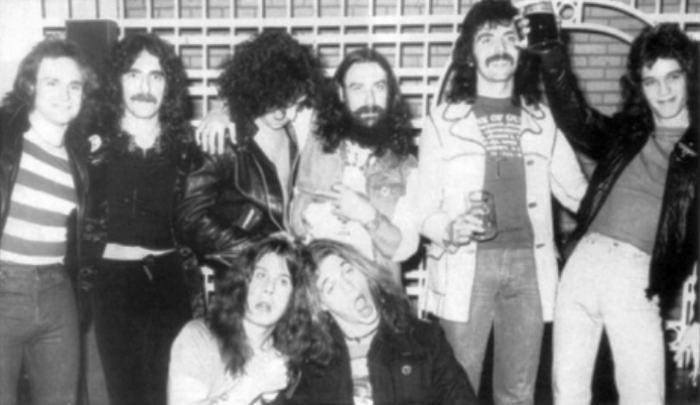 Black Sabbath and Van Halen during the Never Say Die Tour in 1978.
Black Sabbath and Van Halen during the Never Say Die Tour in 1978.
But the real highlight, at least from a fan’s perspective, was the UK leg of their world tour, where they opened for Black Sabbath, who were promoting the Never Say Die album. This was the last legs of the Ozzy-era of Sabbath, with the band going through internal turmoil between them, being creatively-drained and suffering through their fair share of drug addiction, all of this becoming the perfect scenario for a young and hungry Van Halen to blow them off the stage in the ten shows they did together.
“They were very good,” Tony Iommi said about Van Halen in that 1978 tour to Rolling Stone magazine in 2020. “They were very energetic. You’ve got David Lee Roth there, jumping up in the air and doing somersaults, and God knows what else. And the way they’d run around the stage, of course, it was the complete opposite to us; we, like, stood there when we went on (laughs). But they were just a very, very excellent band. You knew then that they were gonna make it. There’s no two ways about it. They just got something that nobody else was doing at that time.”
Both bands quickly hit it off and that friendship evolved into the British men sharing some of their drug habits with the young Americans, to the point that they started to get into cocaine consumption, although David Lee Roth was already dabbing in that territory at the time.
In fact, one of the most notorious anecdotes of this particular tour was the fact that Sabbath had to cancel a show because they simply couldn’t find Ozzy and the reason was because he got himself involved in a very intense session of partying with Roth.
“What I did not know at the time was that David and Ozzy had not merely been hanging out and partying together but had engaged over the previous few days in something they referred to as the Krell Wars,” Monk confirmed in his book. “This was basically a nonstop party (with breaks only for performances, since we were playing practically every night), with a heavy emphasis on cocaine use. The previous night, Ozzy and David had stayed up all night, burying themselves, like Tony Montana, in mountains of coke. The party, David said, went on until nine o’clock in the morning, when our caravan left for Nashville. Keys were distributed upon check-in, and everyone grabbed a nap before wake-up calls were issued and the bands were summoned to the arena for sound check.”
The end result, as you can imagine, was not pretty. And the bands had to cancel the show, pay the fans that bought the tickets and Sabbath had to rearrange the show for another day. Regardless, from Van Halen’s perspective, this tour was a very clear demonstration that they were heading all the way to the top and that they had no qualms in blowing the old guard off the stage in the process.
By the time the tour ended and Van Halen went back home, their debut had sold almost one million copies, they had an ever-increasing following, Edward Van Halen was viewed as the most promising guitar player of the late 70s and they were poised to reach far greater heights with their upcoming albums. They were also on a very poor contract with Warner, but Monk had a plan to make sure they got out of it and profit from a much better deal, which would result in even more commercial success for them, especially in their early days when they were struggling to get by.
Van Halen’s debut is not only one of the best Rock albums of all time and one of the most influential, but it’s also a very clear and definitive musical representation of what this band stood for, showcasing their entire artistic philosophy and what they were all about. A phenomenal album that has aged in great fashion, with Edward, Alex, David and Michael still shining like they were in an eternal Rock dream, every time someone starts playing the opening seconds of Runnin’ with the Devil.
But no one defines the sheer attitude and power of this album better than Edward Van Halen talking about his guitar work in 1978:
“Nobody taught me how to do guitar work: I learned by trial and error. I have messed up a lot of good guitars that way, but now I know what I’m doing, and I can do whatever I want to get them the way I want them. I hate store-bought, off-the-rack guitars. They don’t do what I want them to do, which is kick ass and scream.”
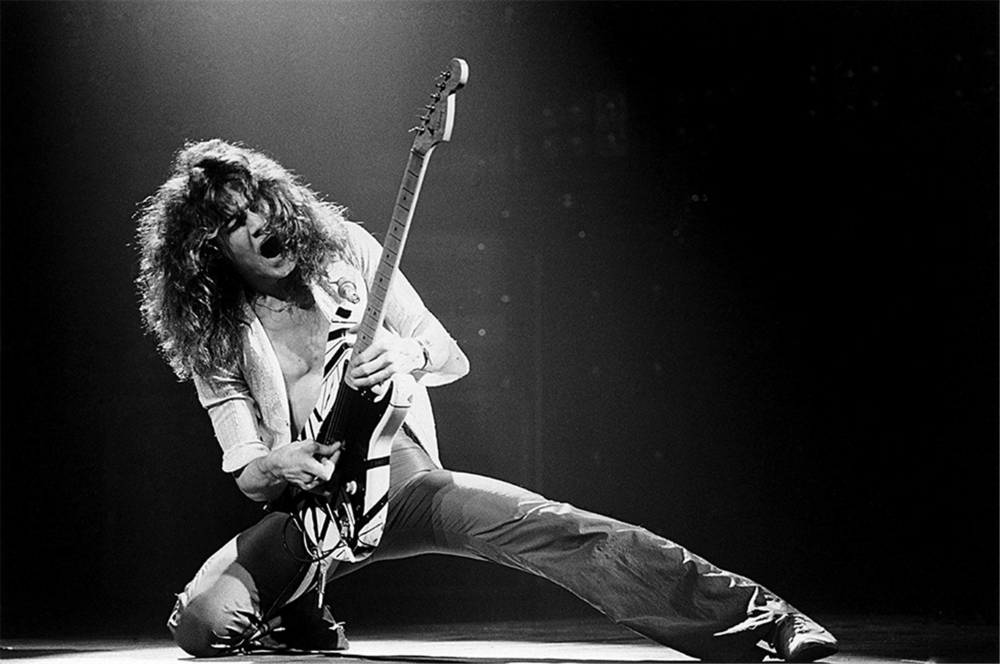 Dedicated to the memory of Edward Van Halen, who passed away in 2020.
Dedicated to the memory of Edward Van Halen, who passed away in 2020.
Author
Kevin Tanza
You may also like
Continue reading
